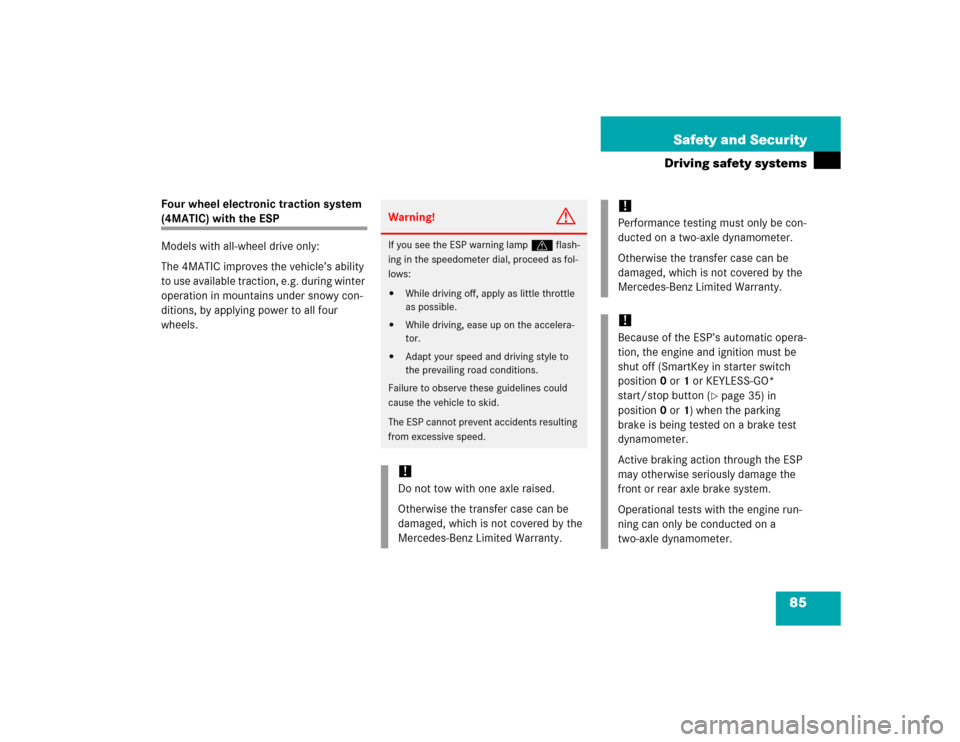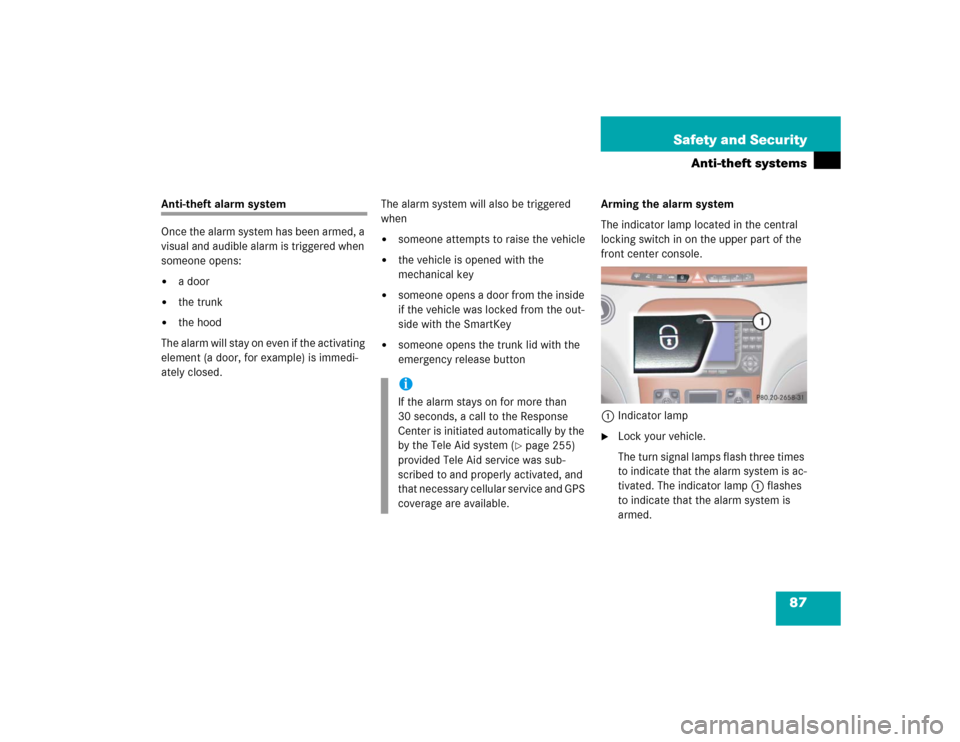Page 83 of 474

81 Safety and Security
Driving safety systems
The - indicator lamp in the instrument
cluster (
�page 24) comes on when you
switch on the ignition (
�page 34). It goes
out when the engine is running.
Braking
At the instant one of the wheels is about to
lock up, a slight pulsation can be felt in the
brake pedal, indicating that the ABS is in
the regulating mode.
�
Keep firm and steady pressure on the
brake pedal while experiencing the pul-
sation.
Continuous, steady brake pedal pressure
yields the advantages provided by the ABS,
namely braking power and the ability to
steer the vehicle.
The pulsating brake pedal can be an indica-
tion of hazardous road conditions and
functions as a reminder to take extra care
while driving.Emergency brake maneuver
�
Keep continuous full pressure on the
brake pedal.
For more information, see “Practical hints”
(
�page 337).
BAS
The Brake Assist System (BAS) operates in
emergency situations. If you apply the
brakes very quickly, the BAS automatically
provides full brake boost, thereby poten-
tially reducing the braking distance.�
Apply continuous full braking pressure
until the emergency braking situation is
over.
The ABS will prevent the wheels from
locking.
When you release the brake pedal, the
brakes function again as normal. The BAS
is then deactivated.
Warning!
G
The ABS cannot prevent the natural laws of
physics from acting on the vehicle, nor can
it increase braking or steering efficiency be-
yond that afforded by the condition of the
vehicle brakes and tires or the traction af-
forded. The ABS cannot prevent accidents,
including those resulting from excessive
speed in turns, following another vehicle too
closely, or hydroplaning. Only a safe, atten-
tive, and skillful driver can prevent acci-
dents. The capabilities of an ABS equipped
vehicle must never be exploited in a reck-
less or dangerous manner which could jeop-
ardize the user’s safety or the safety of
others.
Warning!
G
If the BAS is malfunctioning, the brake sys-
tem is still functioning normally, but without
the additional brake boost available that
BAS would normally provide in an emergen-
cy braking maneuver. Therefore, the braking
distance may increase.
Page 85 of 474

83 Safety and Security
Driving safety systems
For more information, see “Practical hints”
(�page 337).Switching off the ESP
To improve the vehicle's traction, turn off
the ESP in driving situations where it would
be advantageous to have the drive wheels
spin and thus cut into surfaces for better
grip such as:
�
starting out on slippery surfaces and in
deep snow in conjunction with snow
chains
�
in sand or gravel
Warning!
G
The ESP cannot prevent the natural laws of
physics from acting on the vehicle, nor can
it increase the traction afforded. The ESP
cannot prevent accidents, including those
resulting from excessive speed in turns, or
hydroplaning. Only a safe, attentive, and
skillful driver can prevent accidents. The ca-
pabilities of an ESP equipped vehicle must
never be exploited in a reckless or danger-
ous manner which could jeopardize the us-
er’s safety or the safety of others.iDistronic* is switched off when ESP is
activated.iThe ESP will only function properly if
you use wheels of the recommended
tire size (
�page 422).
!Because of the ESP’s automatic opera-
tion, the engine and ignition must be
shut off (SmartKey in starter switch
position0 or1 or KEYLESS-GO
start/stop button* in position0 or1)
when�
the parking brake is being tested on
a brake test dynamometer
�
the vehicle is being towed with the
front/rear axle raised
Active braking action through the ESP
may otherwise seriously damage the
brake system.
Warning!
G
The ESP should not be switched off during
normal driving other than in the circum-
stances described below. Disabling of the
system will reduce vehicle stability in stan-
dard driving maneuvers.iDistronic* cannot be activated when
the ESP has been deactivated.
Page 87 of 474

85 Safety and Security
Driving safety systems
Four wheel electronic traction system (4MATIC) with the ESP
Models with all-wheel drive only:
The 4MATIC improves the vehicle’s ability
to use available traction, e.g. during winter
operation in mountains under snowy con-
ditions, by applying power to all four
wheels.
Warning!
G
If you see the ESP warning lamp v flash-
ing in the speedometer dial, proceed as fol-
lows:�
While driving off, apply as little throttle
as possible.
�
While driving, ease up on the accelera-
tor.
�
Adapt your speed and driving style to
the prevailing road conditions.
Failure to observe these guidelines could
cause the vehicle to skid.
The ESP cannot prevent accidents resulting
from excessive speed.!Do not tow with one axle raised.
Otherwise the transfer case can be
damaged, which is not covered by the
Mercedes-Benz Limited Warranty.
!Performance testing must only be con-
ducted on a two-axle dynamometer.
Otherwise the transfer case can be
damaged, which is not covered by the
Mercedes-Benz Limited Warranty.!Because of the ESP’s automatic opera-
tion, the engine and ignition must be
shut off (SmartKey in starter switch
position0 or1 or KEYLESS-GO*
start/stop button (
�page 35) in
position0 or1) when the parking
brake is being tested on a brake test
dynamometer.
Active braking action through the ESP
may otherwise seriously damage the
front or rear axle brake system.
Operational tests with the engine run-
ning can only be conducted on a
two-axle dynamometer.
Page 89 of 474

87 Safety and Security
Anti-theft systems
Anti-theft alarm system
Once the alarm system has been armed, a
visual and audible alarm is triggered when
someone opens:�
a door
�
the trunk
�
the hood
The alarm will stay on even if the activating
element (a door, for example) is immedi-
ately closed.The alarm system will also be triggered
when
�
someone attempts to raise the vehicle
�
the vehicle is opened with the
mechanical key
�
someone opens a door from the inside
if the vehicle was locked from the out-
side with the SmartKey
�
someone opens the trunk lid with the
emergency release buttonArming the alarm system
The indicator lamp located in the central
locking switch in on the upper part of the
front center console.
1Indicator lamp
�
Lock your vehicle.
The turn signal lamps flash three times
to indicate that the alarm system is ac-
tivated. The indicator lamp1 flashes
to indicate that the alarm system is
armed.
iIf the alarm stays on for more than
30 seconds, a call to the Response
Center is initiated automatically by the
by the Tele Aid system (
�page 255)
provided Tele Aid service was sub-
scribed to and properly activated, and
that necessary cellular service and GPS
coverage are available.
Page 90 of 474
88 Safety and SecurityAnti-theft systemsDisarming the alarm system�
Unlock your vehicle.
The turn signal lamps flash once to in-
dicate that the alarm system is deacti-
vated.Canceling the alarm
To cancel the alarm:
With the SmartKey
�
Insert the SmartKey in the starter
switch.
or
�
Press the Œ or ‹ button on the
SmartKey.
The alarm is canceled.With KEYLESS-GO*
�
Grasp the outside door handle.
The SmartKey with KEYLESS-GO must
be within 3 ft. (1 m) of the vehicle.
or
�
Press the KEYLESS-GO* start/stop
button (
�page 35).
The SmartKey with KEYLESS-GO must
be inside the vehicle.
The alarm is canceled.
iIf the turn signal lamps does not flash
three times one of the following ele-
ments may not be properly closed:�
a door
�
the trunk
�
the hood
Close the respective element and lock
the vehicle again.
iThe alarm system will rearm automati-
cally again after approximately 40 sec-
onds if no door was opened.
Page 91 of 474
89 Safety and Security
Anti-theft systems
Tow-away alarm
Once the tow-away alarm is armed, a visual
and audible alarm will be triggered when
someone attempts to raise the vehicle.Arming tow-away alarm
�
Lock your vehicle.
The tow-away alarm is automatically
armed after about 30 seconds.Disarming tow-away alarm
To prevent triggering the tow-away alarm,
switch off the tow-away alarm feature be-
fore towing the vehicle, or when parking on
a surface subject to movement, such as a
ferry or auto train.
iThe tow-away protection alarm is trig-
gered, for example, if the vehicle is lift-
ed on one side.
If the alarm stays on for more than
30 seconds, a call to the Response
Center is initiated automatically by the
by the Tele Aid system (
�page 255)
provided Tele Aid service was sub-
scribed to and properly activated and
that necessary cellular service and GPS
coverage are available.
Page 92 of 474
90 Safety and SecurityAnti-theft systemsThe button is located on the upper part of
the front center console.
1Indicator lamp
2Tow-away alarm off button
�
Switch off the ignition and remove the
SmartKey from the starter switch.
�
Press button2.
The indicator lamp1 in the button
comes on briefly.
�
Exit the vehicle and lock it with the
SmartKey or (vehicles with
KEYLESS-GO*) the lock button at each
outside door handle or trunk lid.
iYou cannot disarm the tow-away alarm
if the ignition is switched on.
iWhen you unlock your vehicle, the
tow-away protection disarms automati-
cally.
The tow-away alarm remains disarmed
until you lock your vehicle again.
Page 93 of 474
91 Controls in detail
Locking and unlocking
Seats
Memory function
Lighting
Instrument cluster
Control system
Automatic transmission
Good visibility
Automatic climate control
Power windows
Power tilt/sliding sunroof
Driving systems
Loading
Useful features